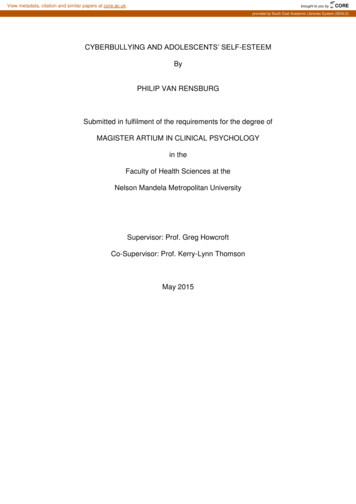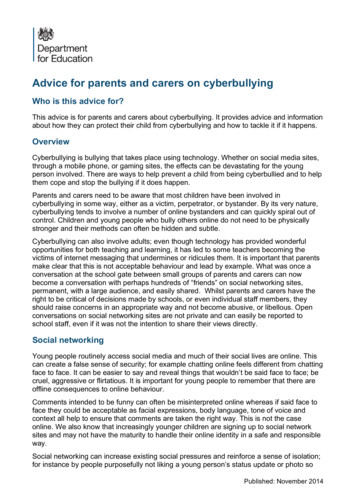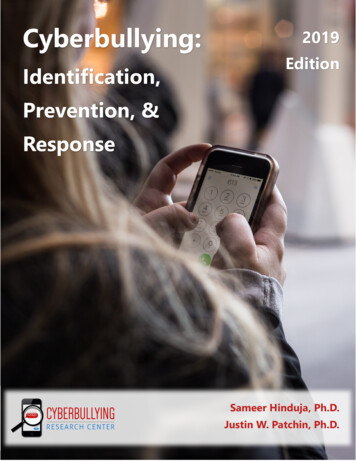
Transcription
View metadata, citation and similar papers at core.ac.ukbrought to you byCOREprovided by South East Academic Libraries System (SEALS)CYBERBULLYING AND ADOLESCENTS’ SELF-ESTEEMByPHILIP VAN RENSBURGSubmitted in fulfilment of the requirements for the degree ofMAGISTER ARTIUM IN CLINICAL PSYCHOLOGYin theFaculty of Health Sciences at theNelson Mandela Metropolitan UniversitySupervisor: Prof. Greg HowcroftCo-Supervisor: Prof. Kerry-Lynn ThomsonMay 2015
iAcknowledgementsSpecial thanks and acknowledgements are extended to the followingindividuals who, through their encouragement, guidance and support, eachcontributed in a meaningful way to the completion of this study:My supervisors, Professor Greg Howcroft and Professor Kerry-LynnThomson, for their enthusiasm, dedication, invaluable advice and supportthroughout this study.Danie Venter, for undertaking to run my statistical analyses. I sincerelyappreciate all of your hard work and the long hours that you have put in toassist me.The principal, teachers and governing body at the school selected for thecurrent study, for their willingness to assist me with this research andflexibility.My parents, Jan and Carolien van Rensburg for the sacrifices they havemade to enable me to further my education, and their constant support andencouragement. I would also want to extend my gratitude to my sisters, Helgeand Janke as well as my Brother in Law, Robert for their support.My wonderful fiancèe, Alysha, for her love, warmth, encouragement andunending support, she is my strength and inspiration.Finally, a special thank you to the grade 7 participants for their enthusiasmand willingness to take part in this study.
iiDECLARATIONI, Philip van Rensburg (212450743), hereby declare that the treatise forMagister Artium in Clinical Psychology to be awarded is my own work and thatit has not previously been submitted for assessment or completion of anypostgraduate qualification to another University or for another qualification. .Philip van Rensburg
iiiTable of contentsAcknowledgementsiTable of contentsiiList of tablesviiiAbstractxChapter 1: Introduction and problem Esteem61.4Primary aims of the research91.5Treatise outline9Chapter 2: Cyberbullying2.1Introduction112.2Defining cyberbullying122.3Cyberbullying versus traditional bullying142.4Context of cyberbullying182.5Prevalence of cyberbullying192.6Causes of cyberbullying212.7Psychosocial consequences of cyberbullying232.8Gender roles and race in cyberbullying312.9Understanding the cybervictim322.10Understanding the cyberbully33
iv2.11Cyberbullying and self-esteem342.12Psychoeducation and cyberbullying362.13Conclusion38Chapter 3: Self-Esteem3.1Introduction403.2Defining self-esteem423.3Normative trajectory of self-esteem across the lifespan443.3.1Self-esteem in childhood453.3.2Self-esteem in adolescence453.3.3Self-esteem in adulthood463.3.4Self-esteem in old age463.3.5Decreasing self-esteem from childhood to adolescence473.3.6Increasing self-esteem from adolescence to adulthood483.4The development of self-esteem493.5The six pillars of self-esteem503.5.1The practice of living consciously513.5.2The practice of self-acceptance523.5.3The practice of self-responsibility543.5.4The practice of self-assertiveness553.5.5The practice of living purposefully553.5.6Personal integrity563.5.7Self-discipline and self-competence563.5.8The practice of self-esteem573.6Gender differences and self-esteem58
v3.7Personality and self-esteem603.8Personality correlates of high self-esteem643.9Personality correlates of low self-esteem673.10Self-esteem, bullying and cyberbullying713.11Conclusion73Chapter 4: Research design and methodology4.1Introduction744.2The primary aims of the research744.3Criteria for selecting an approach744.4The quantitative approach to research764.5Strategies associated with the quantitative approach774.6Research methodology784.6.1Research design784.6.2Descriptive research804.6.3Sampling814.6.3.1Sampling of the grade 7 participants834.6.3.2A description of the participants in the sample854.7Measures854.7.1The biographical questionnaire864.7.2The cyberbully/victim questionnaire864.7.3Battle’s culture-free self-esteem inventories (CFSEI)874.8Method and procedure884.9Data analysis894.10Ethical considerations91
vi4.11Conclusion93Chapter 5: Results and discussion5.1Introduction945.2Socio-demographic profile of the research sample945.2.1Identifying data of the grade 7 sample945.2.2Sample Home language995.3Quantitative findings995.4Results for aim 11005.4.1The prevalence of cyberbullying behaviour5.4.1.1100Number of cyberbullies, cybervictims, cyberbullyvictims and bystanders within each sample1005.4.1.2Frequency of cyberbullying incidents1035.4.1.3Duration of cybervictimisation1045.4.1.4Types of cyberbullying behaviours1065.4.1.5Feelings related to cybervictimisation throughcyberbullying1105.4.1.6Identifying cyberbullies and cybervictims1125.4.1.7Actions taken against cyberbullying1165.55.5.1The cyberbulliesGender of cyberbullies involved in incidents117117
vii5.5.2Age differences between cyberbullies and cybervictims1185.6The cybervictims1195.7The bystanders1205.7.1Bystander behaviour1205.8Summary for aim 1 results1235.9Results for Aim 21245.9.1Internal consistency and reliability of the culture-freeself-esteem inventories1255.9.2Level of defensiveness within each sample1255.10Results of the culture-free self-esteem inventories1265.10.1Self-esteem results for the grade 7 sample1275.10.2General self-esteem scores for the total grade 7sample and for each group5.10.3Social self-esteem scores for the total grade 7sample and for each group5.10.4131Personal self-esteem scores for the total grade 7sample and for each group5.10.7130Parental/Home self-esteem scores for the total grade 7sample and for each group5.10.6130Academic self-esteem scores for the total grade 7sample and for each group5.10.5129132Global self-esteem scores for the total grade 7sample and for each group1325.11ANOVA and correlation results for the grade 7 sample1345.12Summary for aim 2 results136
viii5.13Conclusion138Chapter 6: Conclusions, limitations and recommendations6.1Introduction1396.2Aims of the study revisited1396.3Overall findings and conclusions1396.3.1Prevalence of cyberbullying among grade 7 participiants1396.3.2Relationship between cyberbullying and self-esteem1416.3.3Self-esteem in the grade 7 sample1416.4Limitations of the present research1426.5Recommendations for future research1436.6Conclusion144Reference list145Appendix A: Consent form the school principal165Appendix B: Consent/Assent form for the grade 7 participants169
ixList of tablesTABLE 5.1 Access to a cellphone94TABLE 5.2 Computers linked to the Internet95TABLE 5.3 Access to Internet outside home95TABLE 5.4 Distribution of participants96TABLE 5.5 Distribution of age96TABLE 5.6 Distribution of gender97TABLE 5.7 Distribution of ethnicity98TABLE 5.8 Distribution of home language99TABLE 5.9 Distribution of cyberbullies, cybervictims, cyberbullyvictims and bystanders101TABLE 5.10 Frequency of cybervictimisation103TABLE 5.11 Frequency of cyberbullying offending104TABLE 5.12 Duration of cybervictimisation105TABLE 5.13 Duration of cyberbullying offending106TABLE 5.14 Distribution of the types of cyberbullying victimisation107TABLE 5.15 Distribution of the types of cyberbullying offending109TABLE 5.16 Distribution of the feelings related to victimisation throughcyberbullying110TABLE 5.17 Distribution of the feelings related to offending throughcyberbullying111TABLE 5.18 Identifying data of cyberbullies112TABLE 5.19 Identifying the gender of cyberbullies113TABLE 5.20 Identifying data of cybervictims114TABLE 5.21 Identifying the gender of cybervictims115
xTABLE 5.22 Actions taken against cyberbullying116TABLE 5.23 Gender of cyberbullies involved117TABLE 5.24 Distribution of cyberbullies by grade118TABLE 5.25 Cybervictims’ willingness to inform others and personsinvolved in cybervictims’ self-disclosure119TABLE 5.26 Bystanders of cyberbullying120TABLE 5.27 Bystander behaviour121TABLE 5.28 Internal consistency and reliability of the self-esteeminventories125TABLE 5.29 Defensiveness within the grade 7 sample126TABLE 5.30. Results for the total grade 7 sample127TABLE 5.31. Results for grade 7 cyberbullies, cybervictims,cyberbully-victims and bystandersTABLE 5.32 Results of global self-esteem128133TABLE 5.33 Global self-esteem quotients of cyberbullies, cybervictims,cyberbully-victims and bystanders of the grade 7 sample134TABLE 5.34 Results of ANOVA135TABLE 5.35 Results of the correlational analysis135
xiAbstractCyberbullying can be defined as the wilful and repeated harm inflicted uponothers through the medium of electronic text (Patchin, 2002).Typically,cyberbullying involves sending harassing or threatening e-mails and instantmessages, posting derogatory comments of someone on a website, orphysically threatening or intimidating someone online. The purpose of thisstudy was to investigate the relationship between adolescents’ experiencewith cyberbullying and their level of self-esteem. There is a considerableamount of support, which has been accrued over the years, alluding to thefact that incidents involving bullying have damaging consequences searnedaconsiderable amount of interest is the consequence of bullying on selfesteem. Self-esteem can be defined as a favourable or unfavourable attitudetoward the self. The current research study employed an exploratory,descriptive quantitative research design. Quantitative research focuses onusing empirical data with findings based on certainty. Results areaccumulated through formal measurements using prearranged instrumentsand analysed through the use of statistical measures. Research consisted ofthe completion of a biographical questionnaire which provided data on thedemographics of the sample. The cyber bully/victim questionnaire providedinformation about the prevalence of cyberbullying behaviours among theparticipants. James Battle’s Culture-Free Self-Esteem Inventory was utilisedto measure the construct of self-esteem. Participants were selected by meansof non-probability sampling and comprised of a sample of grade sevenlearners enrolled at a primary school in George, Western Cape. Quantitative
xiidata, obtained from the self-report questionnaires, were analysed through theuse of descriptive statistics, ANOVA statistics and a Pearson R correlation coefficient. One key finding revealed that over fifty percent (51.40%) of thegrade 7 participants had been involved in cyberbullying behaviours. Nosignificant relationship was found to exist between cyberbullying and selfesteem in the grade 7 sample. Self-esteem scores did not vary significantlyamong the cyberbullies, cybervictims, cyberbully-victims and bystanders inthe sample.KEYWORDS: cyberbullying, Internet, online communication, onlineharassment, self-esteem, victimisation, violence.
1Chapter 1Introduction and Primary Aims1.1 IntroductionThis chapter will begin with a general orientation to the current study. Theproblem of cyberbullying will be discussed, and the concept of self-esteem willbe defined. An outline of the aims of the current study will then be provided.This chapter will conclude with a description of the chapter organisation in thecurrent treatise.1.2 CyberbullyingButterfield and Broad (2002) state that social change provides opportunitiesfor the predatory behaviour that is characteristic of a small number of people.With the new technologies that support the Internet, individuals who cannotadjust rapidly to such changes are at risk from those who can and will deploytechnology as a weapon. Cyberbullying is one such example, and has beendefined as the wilful and repeated harm inflicted upon others through themedium of electronic text (Patchin, 2002). The latter is a broad definition thatencapsulates all forms of harassment that commonly occur over the Internetusing either computers or cellular phones.Cyberbullying is a relatively new, yet potentially very harmful phenomenonin which youth use technology such as computers or cell phones to harass,threaten, humiliate or otherwise hassle their peers. It is defined as the “willfuland repeated harm inflicted through the use of computers, cell phones, andother electronic devices” (Patchin & Hinduja, 2010 a, p. 615).Cyberbullying involves, sending mean, vulgar or threatening messages orimages by computer or phone; posting sensitive, private information and/or
2false information about another person online; pretending to be someone elsein order to make a person look bad and/or intentionally excluding someonefrom an online group (Patchin & Hinduja, 2010 b). Patchin and Hinduja(2010 a) provide further examples of cyberbullying which include sendingderogatory emails or text messages, spreading rumours or private informationvia texts or the internet, using social networking sites to make fun of others,and posting embarrassing pictures or videos of others online.In many ways, cyberbullying can be worse, more harmful and harder toterminate than traditional bullying. It can happen both during or outside ofschool hours, and it is less visible to school officials. Images and messagescan quickly be distributed by cyberbullies via the Internet, text or socialnetwork platforms to a wide audience. Additionally, cyberbullying can often beperpetrated by an anonymous offender, which makes it difficult to pinpoint theorigin thereof and subsequently to end (Nunez & Ortega-Ruiz, 2012). .According to Santrock (2004) during adolescence the development of adistinctive identity is significant. Throughout this phase, the progression ofdeveloping an identity is for the most part reliant upon prompts from the socialenvironment, such as societal stereotypes (Oyaziwo, 2006). Adolescents as aresult have a predisposition to search for behaviours and situations that assistthem in valuing themselves in an optimistic manner and to steer clear of thosesituations that make them view themselves in a negative way. This viewcorrelates with adolescents’ awareness and acknowledgment of their evershifting self and plays a significant role in the way in which individualdevelopment will progress (Santrock, 2004).There is a considerable amount of support, which has been accrued over
3the years, for the fact that incidents involving bullying may have certainconsequences with regard to adolescent development. One area that hasearned a considerable amount of interest is that of bullying and self-esteem(Oyaziwo, 2006). Self-esteem can be defined as a favourable (high selfesteem) or unfavourable (low self-esteem) attitude toward the self (Santrock,2004). Additionally, self-esteem can be understood from the viewpoint that itis an internal depiction of social approval and dismissal and a psychologicalgauge used to monitor the degree to which a person is included or excludedby others (Kernis, 1995). The two-abovementioned viewpoints highlight thefact that self-esteem is a perception or belief regarding his or her personalsignificance which is affected by an individual’s contribution to the social world(Oyaziwo, 2008).Existing research on the relationship between bullying and self-esteemindicates that victims of bullying tend to have lower self-esteem than nonvictims (Rigby, 2002). The exact explanation for this connection is notcompletely understood. One explanation could be that through experiencingthe sense of being victimised one’s self-esteem could deteriorate (Sanders &Phye, 2004). Sanders and Phye (2004) point out that another possibility couldbe the fact that those who have a low self-esteem are more likely to betargeted as victims.The association between bullying and self-esteem is much less reliableand often contradictory (Smith, 2009). Previous studies suggest that bulliestend to have both higher and lower self-esteem than non-bullies (Ericson,2001). Some studies also point toward the fact that there is no significantdifference between the self-esteem of bullies and non-bullies (Espelage &
4Swearer, 2003). Even though the direction of the connection between bullyingand self-esteem has not been established yet, research has consistentlyfound that the relationship to self-esteem, regardless of its direction, ispresent among bullies and victims (Juvonen, Graham & Schuster, 2003).It appears as if experiences of traditional bullying are associated withdiffering levels of self-esteem, as it has been indicated that victims of bullyingare likely to have differing levels of self-esteem than non-victims (Oyaziwo,2008). The current researcher hypothesised a similar relationship whenconsidering experiences with cyberbullying. The research question in thecurrent study was whether adolescents who have experienced cyberbullyingreport differing levels of self-esteem than those who have not been victimised.There is limited research on cyberbullying in South Africa. As such, it isunclear how many children are involved in or subjected to these practices.Some limited studies, however, have been conducted. The Centre for Justiceand Crime Prevention (CJCP) conducted a pilot study in 2009 among 1 726young people between the ages of 12 and 24 years. The study found thatalmost half of the respondents (46.8%) had experienced some form ofcyberbullying. Another interesting finding was that there appeared to be arelationship between young people who commit cyberbullying and those whoare the victims of cyberbullying. The study found that 69.7% of respondentswho had bullied others via text messaging had themselves been cyberbullied(Badenhorst, 2011).A study conducted in Port Elizabeth among 1 594 primary and secondaryschool learners indicated that 36% of the respondents had experienced someform of cyberbullying (Von Solms & De Lange, 2011). In another study
5conducted in 2011 about online victimisation of children, conducted by theYouth Research Unit of the Bureau of Market Research at the University ofSouth Africa, it was revealed that 21.46% of the high school pupils surveyedhad been approached with ‘unwanted talk about sex.’ A total of 17.79% saidthey had received e-mails or instant messages with advertisements or links to‘X-rated’ websites. Another 16.95% of the participants indicated that they hadopened messages or links with pictures of naked people or people havingsex, 16.60% had been asked for sexual information about themselves,14.27% were worried or felt threatened by online harassment and 9.90% saidthey had been asked to ‘do something sexual.’ The study also found that maleadolescents were more likely than their female counterparts to engage inunsafe online activities that put them at greater risk of becoming targets ofonline victimisation. The latter behaviour included opening messages showingpictures of naked people or people having sex (50.3%), accessing websitesshowing sexually explicit material (50.9%), or receiving e-mails or instantmessages with advertisements for or links to age-restricted websites (51.3%)(University of South Africa (UNISA), 2011).Although some of the statistics mentioned above refer to another aspect ofonline harassment known as ‘sexting’, the current researcher felt that it alsoforms a significant part of the overarching theme of cybervictimisation. Takingall of the above-mentioned information into consideration, it is subsequentlyimportant to consider the aspect of cyberbullying and self-esteem in theadolescent who experiences cybervictimisation, including ‘sexting’.
61.3 Self-esteemSelf-esteem refers to an individual’s overall self-evaluation of his/hercompetencies; it is the self-evaluation and descriptive conceptualization thatindividuals make and maintain with regard to themselves (Battle, 2014;Santrock 2004). In this sense, self-esteem is a personal evaluation reflectingwhat people think about themselves as individuals. Self-esteem refers to adeveloped attitude about one’s personality (Kaya & Sackes, 2004) and is animportant factor in directing behaviour throughout the various aspects of life(Hamarta, 2004). According to Haney and Durlak (1998), self-esteem reflectsthe degree to which the individual sees him- or herself as a competent, needsatisfying individual. Individuals with high self-esteem have a sense ofpersonal adequacy and a sense of having achieved need-satisfaction in thepast (Kaya & Sackes, 2004). In addition to reflecting cognition about oneself,Taylor, Peplau and Sears (2006) note that self-esteem also consists of anaffective (liking or disliking) component, thus high self-esteem people like whoand what they are. Individuals high in global self-esteem agree withstatements like ‘I am a person of worth, on an equal plane with others’ and ‘Iam satisfied with myself’ (Oyaziwo, 2008).The self-esteem construct is usually conceptualized as a hierarchicalphenomenon. It exists at different levels of specificity, commonly seen interms of global, and task or situation-specific self-esteem ).Asamultifacetedconceptualization of the self, scholars generally agree that self-esteem mayalso develop around a number of other dimensions; including the social,physical, academic, and moral-self (McGee, Williams, & Nada-Raja, 2001).
7The literature that is currently available suggests that high self-esteempromotes goals, expectancies, coping mechanisms and behaviours thatfacilitate productive achievement and impede mental and physical healthproblems (Donnellan, et al, 2005; McGee, Williams, & Nada-Raja, 2001).According to Coopersmith (1967), the attention an individual receives fromother people and the degree of acceptance and respect he or she receivesplays a role in self-esteem development.Kendler, Gardner and Prescott (1998) define self-esteem as the sense ofsatisfaction and self-acceptance that originates from an individual’sassessment of his or her own value, importance, capability and capacity togratify his or her ambitions. According to Taylor et al. (2006), people withhigh-self-esteem have an unmistakable sense of what their individual traitsare. Such individuals think of themselves in a good way, set attainable goals,use feedback in a self-enhancing manner, take pleasure in their positiveencounters and cope effectively with problematic circumstances (Taylor et al.,2006).On the other hand, individuals with low self-esteem think poorly ofthemselves, often opt for goals that are out of reach, are inclined to benegative about the future, have more negative recollections of their past andwallow in their negative states (Taylor et al., 2006). These individuals are lesslikely to produce positive feedback for themselves, are more worried about theimpression other people will have of them, and are more susceptible todepression or rumination when they encounter setbacks or stress (Taylor etal., 2006).Sadock and Sadock (2007) deduce that self-esteem is an assessment of
8one’s sense of value based on perceived accomplishments and success, aswell as an awareness of how much one is valued by peers, family members,teachers and society in general. Sadock and Sadock (2007), go further toclassify self-esteem based on primary and secondary features. The primaryfeatures of positive self-esteem are one’s perception of positive physicalappearance and high value to peers and family. The secondary features ofself-esteem relate to academic achievement, athletic abilities and specialtalents. Adolescent self-esteem is mediated, to a significant degree, bypositive feedback from family members as well as peer groups, thereforeadolescents often seek out a peer group that offers acceptance, regardless ofnegative behaviours associated with that group (Sadock & Sadock, 2007).During adolescence many young individuals move beyond their stable andsecure sense of themselves, as nurtured by their families, and begin todevelop a more personalised vision of themselves and their potential (Tayloret al., 2006). During this time of change as described above, socialnetworking sites can provide a point of stability while facilitating the very typesof personal growth that constitute the identity formation process. Taking thelatter into consideration, it can be confirmed that technology plays a part in theidentity formation of many of today’s adolescents, especially where peerrelations are concerned (Taylor et al., 2006). According to Li (2006) a vastaccess to technology may increase the interaction between peers andresulting peer interactions may affect the way adolescents view themselves.Adolescents want to be part of the rising technological connections their peersare making (Taylor et al., 2006). Taylor et al. (2006) found that removing anadolescent from all the technological platforms that create opportunities for
9cyberbullying also removes them from possible positive social networkingexperiences, and other technological interactions with their peers, which haspreviously been mentioned as an essential construct of identity shaping.The rapid and mounting development of connections and interactions withpeers during adolescence, via technological platforms, has becomeincreasingly important to an adolescent in developing their identity and asense of self (Li, 2006). According to Li (2006), the peers and cliques withwhich learners surround themselves provide them with the opportunities to trynew roles. In the young person’s search for new roles and an integratedidentity, he or she may consistently find that he or she could be a bully orvictim and sometimes even both (Li, 2006).1.4 Primary aims of the researchThe primary aims of the proposed research were:To determine the prevalence of cyberbullying among grade 7 learners inGeorge, Western Cape.To explore and describe the levels of self-esteem of the grade 7 learners whohave experienced cyberbullying and those who have not. The null hypothesiswill be that there will not be a significant difference between the levels of erbullying(independent variable).1.5 Treatise outlineChapter Two provides an overview of the literature on cyberbullying. Theconcept of cyberbullying is defined and information relating to the experienceand aftermath of this phenomenon is presented and discussed. ChapterThree explores the construct of self-esteem, presenting a description of the
10development of this feature. Chapter Four delineates the methodologicalconsiderations taken to develop and conduct this research study. ChapterFive reports and discusses the results of the current study. The conclusionsreached and implications of the research are then presented in Chapter Six.
11Chapter 2Cyberbullying2.1IntroductionWith the current increase in the use of modern forms of technology forinterpersonal communication many doors have been opened for individuals toconnect with each other. The advantages of cyber communication areendless. However, as with any new development, there are some difficultiesthat arise. In this respect cyberbullying is emerging as a negativepsychosocial phenomenon. This form of bullying impacts not only the childreninvolved but also the parents, teachers and other educators caught up in theprocess (Von Marés & Petermann, 2012).The technological revolution, particularly in digital communication toolssuch as the Internet, has brought with it significant changes to the lives ofindividuals and blurs real and virtual worlds and spaces. What has becomeevident with this dramatic rise in the use of handheld devices and mobilephones is that it allows today’s youth to live in a highly mediated world andallows them to stay connected in real time. Growth in the use of technology toconnect with others can be seen in research conducted by the USgovernment in 2002 which indicated that, at that time, about 90% ofadolescents used computers (National Telecommunications and InformationAdministration, 2002).In a study in Sweden it showed that as electronic devices become moreaccessible, it is most likely assured that rates of cyberbullying will alsoescalate (Raskauskas & Stoltz, 2007). In a study by David-Ferdon and Hertz(2007), it was found that almost 80% of adolescents possess the technology
12(primarily computers and cell phones) required to participate in cyberbullying,with even more youth having access to such technology at school, libraries, orafter-school programmes.Cyberbullying peaks in primary school and drops somewhat in high school(Williams & Guerra, 2007). Existing literature reveals a focus on primaryschool pupils, since cyberbullying, like conventional bullying, is likely to bewidespread during this developmental period (Vandebosch & Van Cleemput,2008).2.2Defining cyberbullyingThe current definitions of cyberbullying differ, but most researchers cangenerally agree that it is an intentional, repeated, and aggressive act orbehaviour carried out by a group or individual employing information andcommunication technology as an instrument. The acts which the cyberbullytypically gets involved in are intentionally committed to break down a victimwho cannot easily defend him- or herself or terminate the bullying (Smith,Mahdavi, Carvalho, Fisher, Russell, & Tippett, 2008; Vandebosch & VanCleemput, 2008; Wolak, Mitchell, & Finkelhor, 2007). Aggressiveness,intention, repetitiveness, and a power imbalance are commonly accepted asthe core characteristics of cyberbullying (Dooley, Pyzalski, & Cross, 2009).Cyberbullying includes being cruel to others by sending or posting harmfulmaterial or engaging in other forms of social aggression, using the Internet orother digital technologies. Cyberbullying can take different forms, some ofwhich can be explained by Willard’s (2007) classification of eight forms ofcyberbullying.The first four terms used by Willard (2007) that
3.5 The six pillars of self-esteem 50 3.5.1 Th e practice of living consciously 51 3.5.2 The practice of self-acceptance 52 3.5.3 The practice of self-responsibility 54 . 5.10.6 Personal self-esteem scores for the total grade 7 sample and for each group 132 5.10.7 Global self-esteem scores for the total grade 7 .










